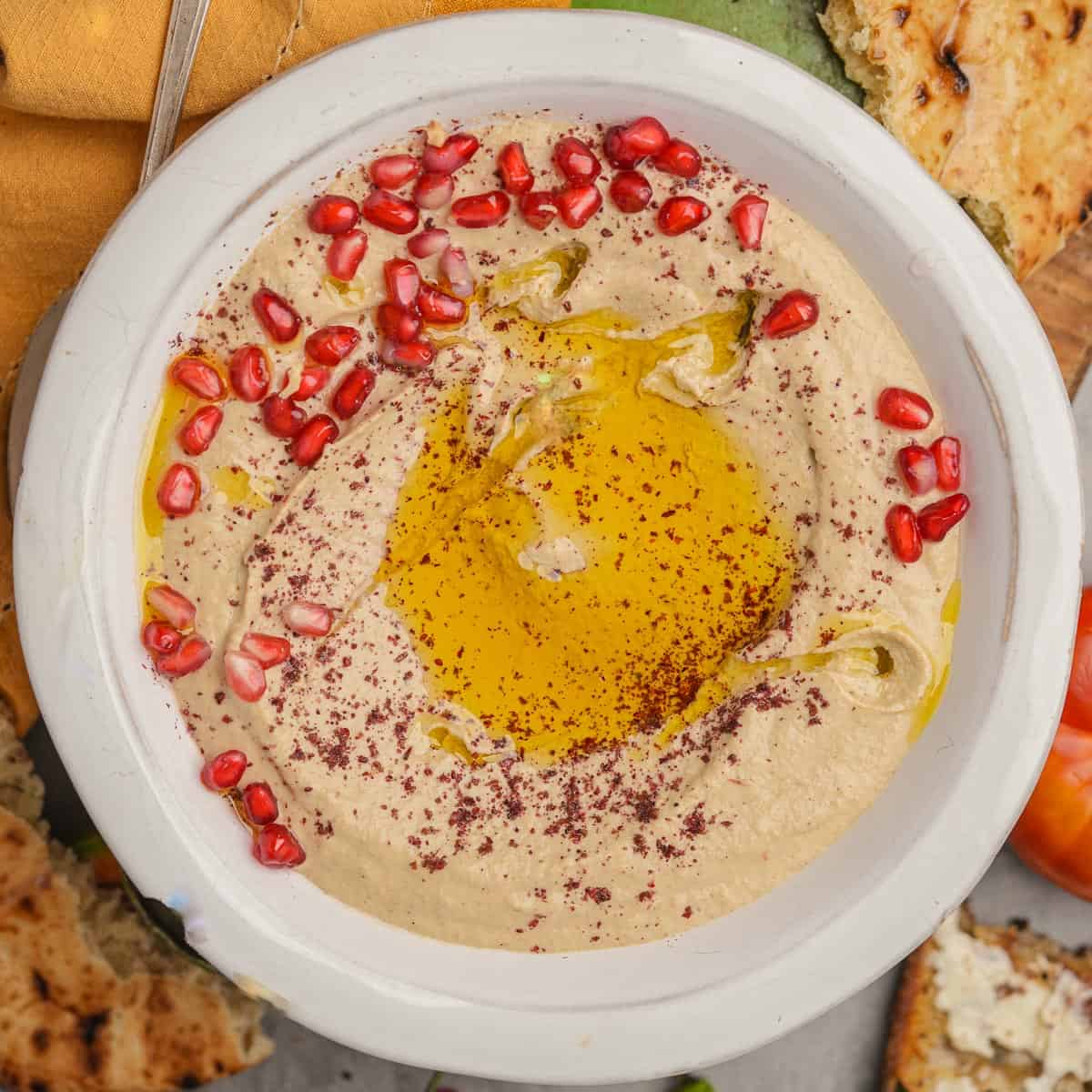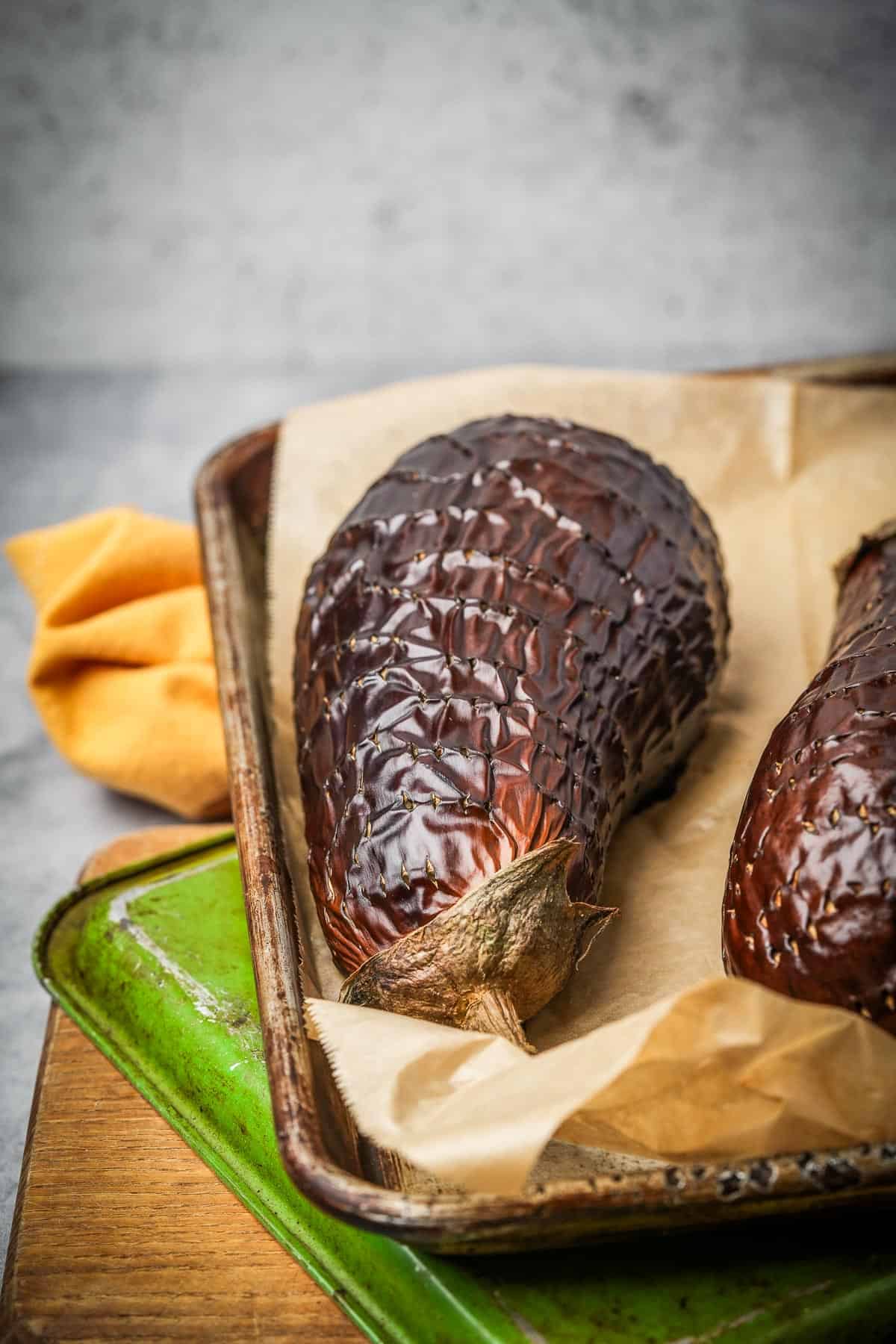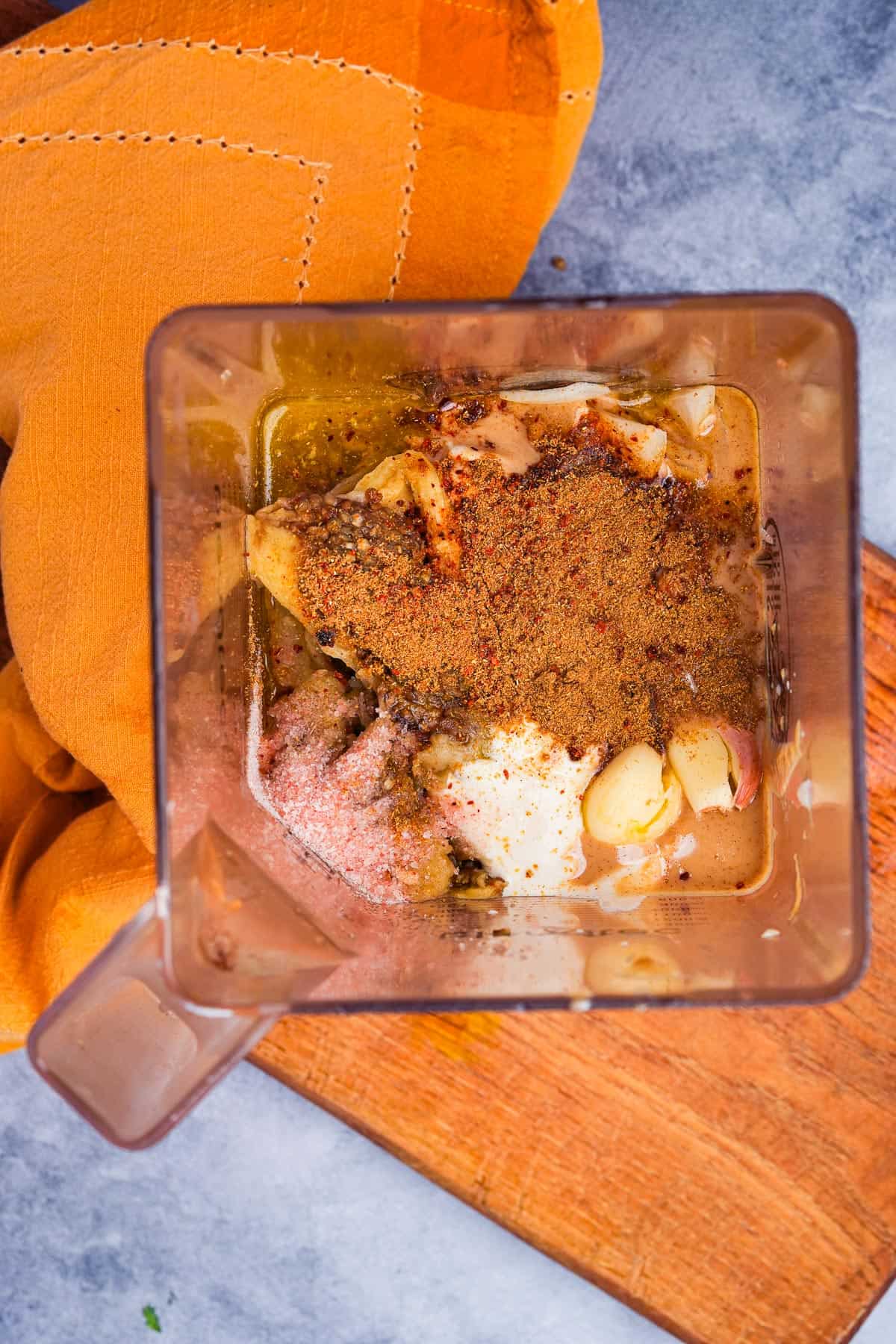*This post may contain affiliate links. Read more »
This Mutabal is a silky, smoky dip will make you grab for more pita bread with each creamy, dreamy spoonful. Mutabal, sometimes known as Moutabbal or Mtabbal, is the Middle Eastern eggplant dip that’s here to steal the spotlight from its famous cousin, Lebanese baba ganoush.


Enter your email & I'll send it to your inbox. Plus, get great new recipes from me every week!
By submitting this form, you consent to receive emails from Cinnamon Snail.
Coming from the Arabic word “mutabbal,” it essentially translates to “smooth” or “to entice.” And that’s precisely what this delightful dip does - tempts and satisfies in equal measure.
This is heaven, especially for people like me who are downright freaks about eggplant. A sprinkling of sumac, Aleppo chili flakes, yogurt and a drizzle of good quality tahini take this recipe to the next level.
What makes me a certified eggplant freak (7 days a week)? It seems like I can’t go a week without testing and writing a new eggplant recipe - from Turkish Şakşuka and Soslu Patlcan Yemegi, to Filipino Ensaladang Talong, Japanese Nasu Dengaku, and Indonesian Sayur Lodeh, let’s just say I can’t get aubergine outta my brain…
Now, you might be thinking, “Can I really make this taste amazing on my own?” The answer is a resounding YES. With this recipe, you’ll be guided every step of the way to make it perfectly and avoid some of the common mistakes that are prevalent in a lot of mutabal recipes.
Get ready to create a dish that’s as beautiful as it is appetizing. Let’s dive in and take your mezze to the next level!
Jump to:
- 🥰Why you are going to adore the ever-loving heck outta this recipe
- 🍆Notable ingredients and substitutions
- 🤯Variations
- 📖 How to make mutabal recipe
- 💡Serving Ideas
- 👉Top tips
- 🤷♀️FAQ
- ✌️My faves to serve with this smoky eggplant recipe:
- Mutabal (The Middle Eastern eggplant dip that’s better than baba ganoush!)
🥰Why you are going to adore the ever-loving heck outta this recipe
🌱 Vegan and Gluten-Free: Like all recipes I share, this dish is free from animal products and cholesterol. It’s also naturally gluten-free!
🍆 Eggplant Magic: Roasting the eggplants to smoky perfection adds an incredible depth of flavor you won’t find from steaming or frying them, and it’s healthier than frying.
🍋 A Touch of Citrus: The lemon juice and sumac work together in this recipe to add a zesty, citrusy kick that elevates the dish from good to outstanding. You will see why this blows baba ghanoush outta the water!
✅ Tested and Approved Worldwide: Like all of my Middle Eastern recipes, I have made Mutabal OVER, AND OVER AGAIN until it was perfect, and then the recipe has been tested in kitchens all around the globe by a large group of recipe testers I work with. My testers love it, finding success with varying ingredient brands available worldwide.


🤘Learn to make killer vegan Middle Eastern food
This guide to my most popular plant-based Middle Eastern recipes is 100% FREE, & you'll love the actual heck out of it 🥰
🍆Notable ingredients and substitutions

Eggplant (Aubergine)
This versatile veggie is the irreplaceable star of Mutabal. Roasting it imparts a smoky flavor and creamy texture, adding depth to the dip. My top recommendation is to use either regular black eggplants or Italian eggplant. Japanese, Chinese, and Thai eggplants will have too high of a skin-to-flesh ratio to be great in this recipe.
Aleppo Chili Flakes
These vibrant red chili flakes hail from Aleppo, Syria. They provide a mild, fruity heat that’s a signature in Middle Eastern dips like muhammara, matbucha and harissa sauce. In Mutabal, they add a subtle spicy kick. If you can’t find Aleppo chili flakes, substitute with gochugaru, or with HALF THE AMOUNT of crushed red pepper flakes for a similar heat.
Tahini Paste
Tahini, made from sesame seeds (packed with calcium!), is a staple in Middle Eastern cooking. I am not talking about using tahini dressing here, just the plain paste. Nothing is quite the same as tahini, but if you can’t eat sesame seeds, you can replace it with almond or cashew butter.
Yogurt
Because I am vegan, I recommend using plant-based yogurt. I particularly like using unsweetened almond milk yogurt. Can you use other yogurts of your choosing? I can’t stop ya, right?
Sumac
Sumac is a deep red spice with a citrusy, tangy flavor. It’s a staple in Middle Eastern and adds a refreshing tang to classics like ezme and Moroccan carrot salad. It’s only really used as a tangy garnish, so if you can’t find it, just make this recipe without it.
Pomegranate Seeds
These jewel-like seeds are both visually stunning and bursting with sweet-tart flavor. They provide a delightful contrast in texture and taste to the dip. If you have never opened a pomegranate before, I recommend checking out my shakarkandi ki chaat recipe, which shows complete instructions for the most efficient way of removing the seeds. If pomegranate seeds are unavailable, try a drizzle of balsamic reduction or a handful of chopped fresh herbs for a fresh, flavorful garnish.
*See the recipe card at the bottom of the page for exact quantities, nutritional info, and detailed cooking directions.
🤯Variations
Roasted Red Pepper Eggplant Mutabal
Roast 2 red bell peppers directly over an open flame for a few minutes on all sides until they’re charred and tender. Once cool, wipe off the charred skin and discard the seeds and stems. Blend it with the roasted eggplant and other ingredients.
Spicy Mutabal
If you’re a heat enthusiast, kick it up a notch by adding a spoonful of shatta or aci biber salcasi. You can garnish it with pickled green chilies for all the different dimensions of spicy you need in your life.
📖 How to make mutabal recipe
Nail this on your first shot by following these step-by-step instructions with useful tips. Or you can follow along with the easy-to-print recipe card towards the bottom of this page.

Step One
Preheat Oven:
Begin by preheating your oven to 425°F (220°C). Wash the eggplants thoroughly and deeply pierce them all over with a fork. This prevents bursting during roasting and ensures even cooking.

Step Two
Roast Eggplants:
Place the prepared eggplants on a baking sheet lined with parchment paper. Roast them for 45 minutes, until they’re tender and the skin shows a slight char and wrinkling. The eggplant should be soft to the touch all around.

Step Three
Toast Spices:
While the eggplants roast, toast the cumin, coriander, and Aleppo chili flakes in a dry skillet over low heat for about 3 minutes, constantly stirring until fragrant.

Step Four
Prep Eggplant Flesh:
After roasting, allow the eggplants to cool slightly. Cut them in half, scoop out the flesh, and discard the skins. Don’t freak out if you end up with a tiny bit of skin sticking here or there to the eggplant. It's not the end of the world at all.

Step Five
Blend:
In a blender or food processor, combine the roasted eggplant flesh with the toasted spices, chopped onion, garlic, tahini paste, yogurt, lemon juice, salt, and olive oil. Process the mixture for 2 minutes until it’s smooth and well blended.

Step Six
Serve and Garnish:
Transfer the dip to a serving bowl. Drizzle generously with extra virgin olive oil and garnish with sumac and pomegranate seeds. Optionally swirl a little zhoug sauce or harissa sauce into it if you like heat.
Scoop it up with freshly grilled pita bread, parotta, or potato-stuffed kulcha!
💡Serving Ideas
Mutabal makes a great mezze item, or condiment in a Middle Eastern feast to slather onto Afghani bolani bread.
Start with a hearty helping of Turkish borlotti beans, their rich flavors harmonizing with the creamy eggplant dip. Serve mutabal with freshly grilled sourdough bread alongside your favorite Middle Eastern soups or stews like ezogelin, yalya corbasi, loubia, or Moroccan harira.
Olive oil-braised kereviz root offers a unique and earthy side dish, while the Baharat Roasted Mushroom Shawarma or Seitan Kofta make for a more filling meal.
The creamy gnarliness of Mutabal nicely complements grain dishes like tabouli, bulgur pilavi, fellah koftesi, cig kofte, and mercimek kofte.
To conclude your meal on a sweet note, you 100% need to smash traditional Middle Eastern dessert like irmik helvasi or Persian baklava.

👉Top tips
- Perfectly Roasted Eggplants: Tender, smoky roasted eggplants are the cornerstone of this dish. Pierce the eggplants deeply and ensure they are roasted until the skin is slightly charred and the flesh is tender. If it doesn’t feel fully tender when your timer goes, give it some extra time. Undercooked eggplant suckkkkkkks. So don’t rush this step!
- Balanced Spices: Toasting the cumin, coriander, and Aleppo chili flakes is essential. Ensure they release their aroma but don’t burn. This step will add more complex layers of flavor to your Mutabal.
- Creamy Texture: When blending the ingredients, aim for a smooth and well-combined mixture. A high-speed blender like a Blendtec is the best option for the creamiest, most thorough puree. A food processor will work too, but it just might need some more time, and will not be 100% as smooth and creamy as the blender will get it. If you have a crappy blender, do it in your food processor instead.
- Tahini Selection: Use a high-quality tahini paste, and make sure it’s well incorporated into the dip. The nutty richness of tahini adds depth to the flavor profile.
- Garnish with Style: A little extra care to nail the presentation is worth it. Spread the mutabal in a smooth shape using the backside of a large serving spoon in a dish before drizzling with extra virgin olive oil and garnishing with sumac, pomegranate seeds, and optionally some fresh parsley or dill. I think the most attractive look is to sprinkle the pomegranate seeds in a C-shape around the bowl’s perimeter.
🤷♀️FAQ
Store it in an airtight container in the refrigerator for up to four days.
Freezing will absolutely wreck the dip’s silky texture, so I do not recommend it!
You can control the spice by varying the amount of Aleppo chili flakes or by adding fresh chili if you prefer a spicier kick. As it is, this recipe is more garlicky than it is spicy, and the sweetness of the pomegranate seeds on top further eases the tiny bit of bite.
It’s typically pronounced as “moo-tuh-bahl” with the emphasis on the second syllable.
Mutabal has its roots in Middle Eastern cuisine, particularly in countries like Lebanon and Syria. It’s a classic dish with variations across the region, and its history dates back centuries as a flavorful dip or side dish.
✌️My faves to serve with this smoky eggplant recipe:
Say Hi on Social! 👋
Follow me on Instagram & Facebook for more recipes.
❤️Love this recipe? It helps me out greatly if you leave a 5-star 🌟🌟🌟🌟🌟rating in the recipe card below and maybe even leave me a lovey-dovey comment too!

Mutabal (The Middle Eastern eggplant dip that’s better than baba ganoush!)
Equipment
- Oven
Ingredients
- 2 large eggplants (2.2 lb. / 1 kg.)
- 1 teaspoon cumin
- ½ teaspoon coriander
- ½ teaspoon Aleppo pepper flakes or crushed red pepper flakes
- ¼ cup chopped onion
- 2 cloves garlic peeled
- ⅓ cup tahini paste
- ⅓ cup yogurt (I use plain, unsweetened almond milk yogurt)
- 3 tablespoons lemon juice
- 1 teaspoon salt or to taste
- ¼ cup extra virgin olive oil
To garnish:
- ½ teaspoon sumac
- 1 tablespoon extra virgin olive oil
- 3 tablespoons pomegranate seeds
- Parsley or dill optional
Instructions
- Preheat your oven to 425 degrees Fahrenheit (220 degrees Celsius). Wash the eggplants and pierce them deeply all over with a fork to prevent bursting during roasting, and to help the heat penetrate within.
- Place the eggplants on a parchment paper lined baking sheet and roast them for 40-45 minutes, or until they are tender and the skin is slightly charred.
- While the eggplants are roasting, in a dry skillet, lightly toast the cumin, coriander, and Aleppo chili flakes over low heat for about 4 minutes until fragrant. Remove from heat.
- Once the eggplants are done, remove them from the oven and let them cool slightly. Then, cut them in half, scoop out the flesh, and discard the skins.
- Place the eggplant into a food processor along with the toasted spices, onion, garlic, tahini paste, yogurt, lemon juice, salt and olive oil.
- Process the mixture until it’s smooth and well combined. If it’s too thick, you can add a bit of water to achieve your desired consistency.
- Transfer the dip to a serving bowl. Drizzle it liberally with extra virgin olive oil, and garnish with sumac, pomegranate seeds, and optionally parsley or dill.
Notes

Enter your email & I'll send it to your inbox. Plus, get great new recipes from me every week!
By submitting this form, you consent to receive emails from Cinnamon Snail.











Sarah says
Move over hummus, this is my new favorite dip! So easy to make and it’s delicious.
Meg says
This was excellent. As suggested, I made Zhoug and Afghani Balani…and the Kofka with tzatziki. What a freaking feast!
Thank you.
Heva says
Easy to make and enjoy! Highly recommended.
Akriti says
AMAZING!!!!!
Heather says
This a great addition to my mezze plate with Arabic pita bread so easy and great tasting. Definitely worth 6 stars